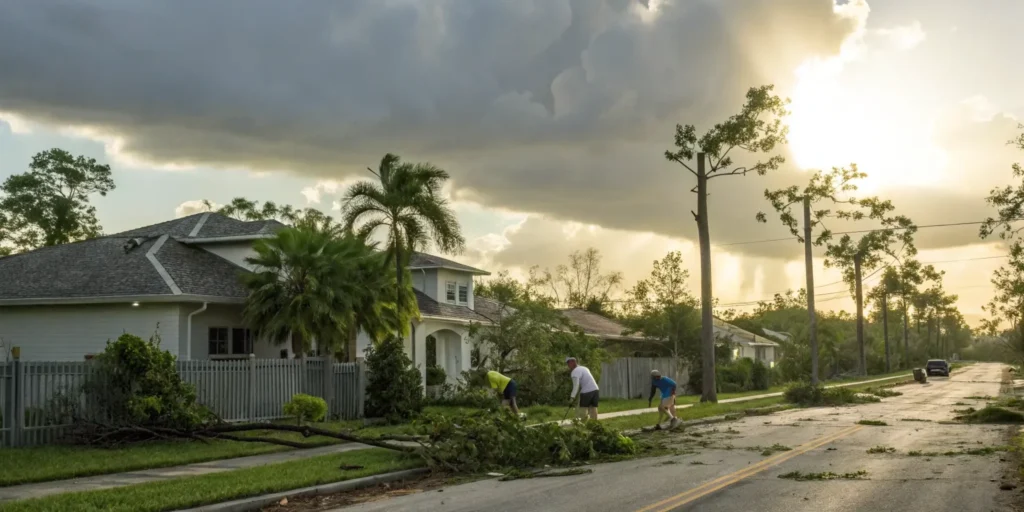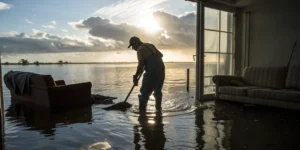Damage Repair After a Hurricane
The winds have died down, the rain has stopped, and you’re finally able to step outside. The first look at your home after a hurricane is a moment filled with anxiety and the overwhelming urge to start putting things right. As you survey the damage—scattered debris, water pooling in corners, shingles littering your lawn—the questions start racing through your mind. What can I handle myself? What’s truly dangerous? Where do I even begin?
Your first instinct might be to grab the ladder and toolbox. While that proactive spirit is commendable, knowing where to draw the line between a simple DIY cleanup and a dangerous repair is the most important decision you’ll make. The difference between these two paths can mean the difference between a quick recovery and months of escalating problems, including structural failure, toxic mold growth, and denied insurance claims.
This guide will help you assess the damage to your home, identify the clear “red flags” that demand a professional, and understand the hidden risks—like mold and structural failure—that can turn a manageable problem into a catastrophe. By the end, you’ll have a clear action plan that protects both your home and your family’s safety.
The “Green Light” List: Safe DIY Tasks for Immediate Triage
Not every post-hurricane task requires a professional. In fact, there are several critical steps you can and should take immediately to begin the recovery process. These safe, actionable tasks help you regain control while minimizing further damage.
Documentation is Your #1 Job: Before you touch, move, or repair anything, pull out your phone and thoroughly photograph and video every bit of damage. Capture wide shots showing the full extent of the problem, then close-ups of specific issues. Document damage to your roof, siding, windows, interior walls, floors, and belongings. This visual evidence is essential for your insurance claim and creates a clear record of what happened during the storm, not after.
Clearing Minor Debris: You can safely remove fallen leaves, small branches, and loose items from your yard, driveway, and easily accessible gutters. If you can reach it from the ground with a rake or by hand, it’s generally safe to clear. This prevents clogged drainage systems and allows water to flow away from your foundation.
Interior Water Cleanup: If you have puddles, damp carpets, or soaked furniture, start the drying process immediately. Mop up standing water, use fans to increase air circulation, and run dehumidifiers to pull moisture from the air. Move wet furniture away from walls to allow airflow on all sides. The faster you dry things out, the better your chances of preventing mold.
Covering Small Openings: A small crack in a window or a minor hole in siding can be temporarily covered to prevent additional rain from entering your home. Heavy-duty tape, plastic sheeting, or a piece of plywood can work as a short-term barrier. Keep these repairs simple and temporary—this is about damage control, not permanent fixes.
Sorting Damaged Belongings: Take inventory of what’s been affected. Move salvageable items to a dry, safe area. Separate items that are clearly ruined from those that might be saved. This organizational step makes the insurance claims process smoother and helps you mentally process what comes next.
These tasks give you a productive starting point and help you feel less helpless in the immediate aftermath. However, they represent the full extent of what most homeowners should attempt on their own. Beyond this point, the risks escalate dramatically.
The “Red Flag” Hurricane Damage Checklist: Stop and Call a Professional Immediately If You See This
Certain types of hurricane damage should never be approached as a DIY project. These situations involve serious safety risks, specialized knowledge, and equipment that only trained professionals possess. If you observe any of the following conditions, stop what you’re doing and call for expert help immediately.
Major Roofing Damage
Signs to watch for: More than just a few missing shingles, large holes or punctures in the roof surface, visible sagging or dipping in the roofline, exposed roof decking or underlayment, damage to the flashing around chimneys or vents, or significant debris embedded in the roof structure.
Why a professional is essential: Roof work is inherently dangerous, with falls being one of the leading causes of homeowner injuries. Beyond the immediate fall risk, roofing requires specialized equipment, knowledge of proper installation techniques, and the ability to spot subtle damage that isn’t visible from the ground. A professional can identify compromised roof decking, damaged trusses, and small leaks that will cause massive interior damage over time. They also understand how to properly integrate repairs with your existing roofing system to maintain your warranty and ensure waterproof integrity.
Structural or Foundation Issues
Signs to watch for: New, large cracks appearing in foundation walls or interior drywall, especially diagonal cracks above doorways and windows. Doors that suddenly stick, won’t close properly, or have gaps where they used to fit snugly. Windows that are newly misaligned or difficult to open. Floors that feel spongy, bouncy, or noticeably sloped where they were level before. Separation between walls and ceilings, or walls pulling away from the structure.
Why a professional is essential: These signs indicate that your home’s core structural integrity has been compromised. This is not cosmetic damage—it’s a warning that the forces holding your house together have been disrupted. A structural engineer or specialized foundation contractor needs to assess the damage, determine the cause, and design a repair strategy. Ignoring these signs or attempting amateur repairs can lead to progressive failure, where the damage continues to worsen under the home’s own weight and external forces. In severe cases, structural failure can make a home uninhabitable or even lead to collapse.
Significant Water Intrusion
Signs to watch for: Water stains spreading across ceilings or walls, soaked or dripping insulation, standing water more than an inch deep in any room, basement, or crawlspace. Water flowing from wall cavities or light fixtures. Bulging or bubbling paint or drywall. A musty smell developing within hours of the storm.
Why a professional is essential: The water you can see is often just the tip of the iceberg. Water follows paths of least resistance, flowing through wall cavities, beneath floors, and into hidden spaces where it sits and breeds mold. Professional water damage restoration companies use moisture meters, thermal imaging cameras, and industrial-grade dehumidification equipment to find and eliminate hidden water that would be impossible to locate and remove on your own. They also understand the science of drying—knowing which materials need to be removed entirely versus dried in place, and how to prevent secondary damage like warping and mold growth.
Electrical System Damage
Signs to watch for: Lights flickering or dimming repeatedly after power is restored. Buzzing, crackling, or popping sounds coming from outlets, switches, or the breaker box. Visible discoloration or burning smell near electrical components. Any indication that your electrical panel, outlets, or wiring were submerged in water, even briefly. Outlets that feel warm to the touch or circuit breakers that trip repeatedly.
Why a professional is essential: Water and electricity create an immediate, life-threatening combination. Even after water has dried, residual moisture in electrical components, corrosion on contacts, and compromised insulation create extreme risks of electrocution and electrical fires. A licensed electrician needs to inspect your entire system, test for ground faults, check for compromised circuits, and verify that everything is safe before you use it normally. This is not an area where you can afford to take chances—electrical issues can be fatal or destroy your home in minutes.
Felled Trees on Structures
Signs to watch for: A large tree, substantial limbs, or multiple branches resting on your roof, garage, shed, or the side of your house. Trees leaning against the structure or caught in power lines. Partially uprooted trees that could shift or fall completely.
Why a professional is essential: Trees are deceptively heavy and almost always under immense tension when they’re resting on a structure. The weight distribution and stress points are complex and constantly shifting. Attempting to remove a tree yourself with basic tools can cause the tree to suddenly shift, roll, or drop, leading to catastrophic structural collapse, crushed vehicles, and serious injury or death. Professional tree removal companies and structural repair contractors have specialized equipment like cranes, harnesses, and rigging systems to safely remove the tree piece by piece while supporting the structure underneath. They also have the insurance coverage to handle the inherent risks.
The Hidden Dangers: Why “Waiting to See” is a Costly Mistake
One of the most dangerous misconceptions after hurricane damage is that you have plenty of time to decide what to do. The reality is that hurricane damage is rarely static—it’s almost always progressive. What seems manageable today can transform into a catastrophic problem within days or weeks. Understanding these hidden dangers helps explain why immediate professional assessment is so critical.
The 48-Hour Mold Clock: This is the most underestimated threat after water intrusion. Mold spores are everywhere in the environment, just waiting for the right conditions to activate and multiply. When your home has hidden moisture trapped in wall cavities, beneath flooring, or in insulation, those areas become perfect mold incubators. Within 24 to 48 hours, mold colonies begin growing in these dark, damp spaces. By the time you see visible mold growth or smell that distinctive musty odor, the problem is already extensive. What started as a roof leak or water intrusion that seemed contained has now become a toxic mold remediation project costing thousands of dollars more than the original repair would have. Even worse, certain types of mold pose serious health risks, particularly for children, elderly family members, and anyone with respiratory conditions.
The Domino Effect of Structural Damage: Structural damage doesn’t heal itself or remain stable over time. When a roof truss is compromised, a foundation wall is cracked, or floor joists are weakened, the structure continues bearing the same loads it always has—but now with reduced capacity. Every day of wind, every heavy rain, every person walking across that floor adds stress to an already compromised system. The damage spreads. That small foundation crack widens. That slightly sagging roofline begins to sag more noticeably. Eventually, you reach a tipping point where the repair becomes exponentially more complex and expensive. A roof repair that would have cost a few thousand dollars becomes a full roof replacement costing tens of thousands. A foundation crack that could have been stabilized with epoxy injection now requires extensive excavation and structural reinforcement.
The Insurance Complication: Your insurance policy requires you to act as a reasonable and responsible homeowner. This means taking prompt action to prevent additional damage beyond what the hurricane caused. If you know you have a hole in your roof but don’t cover it temporarily, and subsequent rainstorms cause extensive water damage to your interior, your insurance company may deny that portion of your claim. They’ll argue that the additional damage was preventable and resulted from your negligence rather than the covered storm event. Similarly, if you attempt DIY repairs that make the damage worse or obscure the original damage before an adjuster can document it, you may inadvertently complicate or jeopardize your claim. Professional contractors understand how to document damage properly, communicate with insurance adjusters, and perform temporary mitigation work that protects both your home and your claim.
The pattern is clear: hesitation and delay transform manageable problems into disasters. The money you think you’re saving by waiting or attempting DIY fixes is usually multiplied several times over in increased repair costs, mold remediation, and potential insurance complications.
Finding a Trustworthy Professional for Roof Repair and Hurricane Damage Repair in the Aftermath
Unfortunately, major disasters attract not only legitimate professionals but also opportunistic scammers who prey on vulnerable homeowners. In the chaotic aftermath of a hurricane, when you’re stressed and desperate for help, it’s easy to make poor decisions about contractors. Protecting yourself requires knowing what to look for and what red flags to avoid.
Ask for proof of license and insurance: Every legitimate contractor should have a current state license and both liability insurance and workers’ compensation coverage. Don’t take their word for it—ask to see the actual certificates and verify them with the issuing agencies. A contractor without proper insurance puts you at serious financial and legal risk if someone is injured on your property or if their work causes additional damage.
Get multiple written estimates: Contact at least three reputable contractors and get detailed, written estimates from each. These estimates should break down labor, materials, and timeline. Be suspicious of estimates that are dramatically lower than others—they often indicate corner-cutting, substandard materials, or plans to demand additional payments once work begins.
Check local references and reviews: Look for contractors with established local businesses and verified customer reviews. Ask for references from recent projects similar to yours, and actually call those references. Online review platforms like Google, Better Business Bureau, and specialized contractor review sites can reveal patterns of problems. Pay special attention to how contractors respond to negative reviews—this shows their professionalism and accountability.
Be wary of anyone demanding full payment in cash upfront: Legitimate contractors typically ask for a reasonable deposit, with the balance due upon completion or in scheduled installments as work progresses. Anyone demanding full payment before starting work, insisting on cash only, or pressuring you to decide immediately is almost certainly a scam. These storm-chasers collect money and disappear, leaving you with no recourse.
Get a detailed contract before any work begins: Never allow work to start based on a handshake or verbal agreement. A professional contract should specify exactly what work will be performed, what materials will be used (including brand names and grades), the project timeline, payment schedule, warranty information, and how changes or disputes will be handled. Both parties should sign and date it, and you should keep a copy.
Taking these precautions adds a few days to your timeline, but it protects you from scams that could leave you in a far worse position than the hurricane did.
Your Home’s Health is Your Priority
The hidden dangers of mold growth, structural failure, and insurance complications mean amateur repairs almost always cost more than immediate professional intervention. What looks like money-saving DIY often transforms into a financial disaster.
When in doubt, get it checked out. Professional inspection might cost a few hundred dollars, but it’s a fraction of what you’ll spend on emergency mold remediation, extensive repairs, or battling denied insurance claims.
Protect your investment and your family’s safety. Contact SuperClean Restoration Services at 844-888-0837 or email Info@supercleanrestorationpb.com for a certified assessment today. Your home has weathered the storm—ensure your recovery decisions don’t create a bigger disaster.




